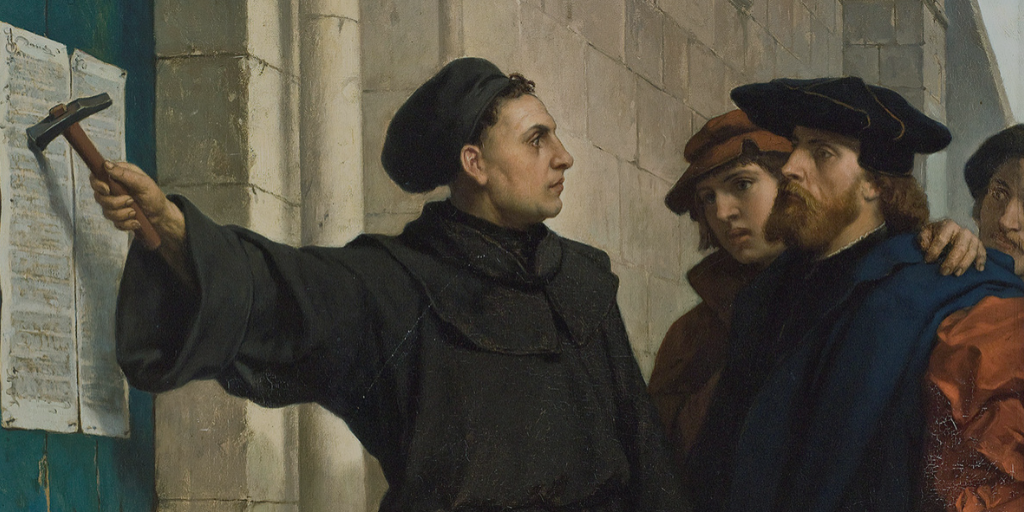An overview of the Reformation, remembering some of its major players and what they taught, and how God used the Reformation protected his true church from error.
On October 31, 1517, Martin Luther nailed 95 theses to the Wittenberg Cathedral door. The obscure Augustinian Monk was attempting to start a scholarly debate on various abuses in the church. Instead, he started a religious revolution.
In 2017, we celebrated the 500th anniversary of the birth of the Reformation. The Protestant Reformation, usually just referred to as the Reformation, was a 16th century religious reform movement that began inside the Catholic Church and eventually splintered the church causing widespread religious, cultural, and intellectual upheaval in Europe. Those who sided with the Reformers were called Protestants since they “protested” the dominant Catholic Church while those who sided with the Catholic Church remained Catholics or Roman Catholics.
Much has changed since the Reformers preached in Europe five centuries ago. Instead of mounting horses and carts to attend Mass, people now travel in cars and trains to attend services each Lord’s Day. Many don’t attend church at all because of the changing religious practices in Europe and Western world – some of which date back to the Reformation. But despite the passage of time, it’s good to reflect on what caused the division and how God used it to protect his true church.
In this post, my aim is to provide an overview of the Reformation, remember some of its major players, and how God used the Reformation protected his church from error.
Precursors to the Reformation: Lights Shining From the Darkness
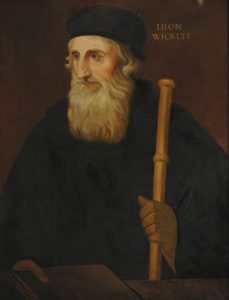
Kirkby, Thomas; John Wycliffe (c.1330-1384); Balliol College, University of Oxford. Image credit: Wikimedia
In many ways, the Reformation did not begin in 1517. There were several Christian leaders and reform movements that preceded the 16th century.
For instance, John Wycliffe (1320-1384) was born nearly 200 years before Reformation. Wycliffe held many of the later Protestant beliefs including rejecting indulgences (paying for forgiveness), justification by faith alone, and believing the Scriptures should be read in the language of the people. Wycliffe oversaw the translation of the entire Latin Bible into the English language. Though that translation was a treacherous act in Catholic Europe, Wycliffe died before he could be tried for heresy. Wycliffe’s followers were known as Lollards.
Other pre-Reformation leaders rose in other parts of Europe. Jan Hus, aka John Huss (1369-1415) lived a generation after Wycliffe. The Bohemian-born Hus held similar beliefs to his English counterpart but suffered a worse fate at the hands of the Catholics by being burned at the stake in 1415. Hus’s followers were called the Hussites and were forerunners to the later Moravians in present-day Czechia.
Other forerunners to the Reformation included Giroloma Savonarola (1452-1498) in Florence, Italy. Savonarola was later martyred by burning for his prophet-like denunciations against clerical and civic abuses. The earliest of the pre-Reformers was Peter Waldo (1140-1205). Waldo either founded or was involved in the Waldensian movement in Lyon, France. The Waldensians rejected Papal authority in Catholic Europe before any other group in Europe.
There were earlier protests of Catholic doctrine and practices before Martin Luther and many of the disputes were similar to those leveled during the Reformation. However, none of the movements overthrew Catholic hegemony in Europe until the 16th century.
“You yourselves like living stones are being built up as a spiritual house, to be a holy priesthood, to offer spiritual sacrifices acceptable to God through Jesus Christ.” (1 Peter 2:5)
Magisterial Reformation: Church Reform Within The State
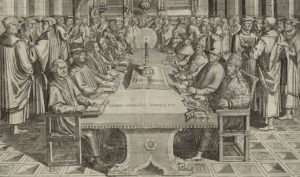
A fictitious dispute between Protestant Reformers & Catholic Leaders – Image Credit Wikimedia
Martin Luther (1483-1546) became a fastidious, Augustinian monk in Germany in 1505. Luther began teaching the Bible and grew weary of official Catholic teachings about repentance from sins, penance, indulgences, Papal authority, and purgatory finding no basis in Scripture for much Catholic dogma. After he nailed the 95 Theses to the cathedral door, he set the wheels in motion for his eventual excommunication and condemnation as a heretic and his eventual commendation as the founder and pastor in what would become the Lutheran denomination alongside his fellow-leader, Philip Melanchthon. Luther enjoyed wide support in Germany and protection from secular princes. He was one of the more famous, if divisive, leaders of the Reformation (and one of my personal heroes).
Shortly after Luther began railing against the Pope in Germany, the winds of Reformation change were blowing in England. The English Reformation was a series of political and ecclesiastical events where the Church of England ultimately separated from the Catholic Church. It started when King Henry VIII (1491-1547) annulled his marriage to his deeply Catholic Queen Catherine to marry Anne Boleyn in 1533. The Pope would not grant Henry’s divorce, but Parliament complied with the King’s wishes and later gave the king the title “Supreme Head on earth of the Church of England” in the Act of Supremacy in 1534.
On the church side, Thomas Cranmer (1489-1556) was instrumental in reshaping the soon-to-become Protestant Church of England when he became Archbishop in 1533. Though more moderate in his theology, Cranmer denied Papal authority over the English church and rejected transubstantiation. He wrote the first (mildly) Protestant prayer book in 1552 and later the 42 Articles of the Church of England (1553) – a set of foundational doctrines of the English Church. However, when the Catholic Queen Mary (aka Bloody Mary) ascended to the throne, she turned the country back to Rome briefly and ensured Cranmer die a martyr’s death by burning.
In Switzerland, two reformers are remembered more than others. A contemporary of Luther, Ulrich Zwingli (1484-1531) led the reform movement in Zurich under the protection of the magistrates. Zwingli emphasized Christ first and the church second and began developing the framework for the Swiss Reformation. As a priest, he married secretly, then broke a Lenten fast by eating sausages in public. Zwingli famously disagreed with Luther’s view on the Eucharist in 1529 so the Swiss and German wings of the Reformation would never unite.
The Frenchman John Calvin (1509-1564) was a more well-known leader of the Swiss Reformation after Zwingli. Calvin published his monumental Institutes of the Christian Religion in 1536. Like all Protestant leaders of the early Reformation, he was a wanted man. Fleeing Catholic France, he landed in Geneva where he was compelled to pastor the city’s first Protestant church. Calvin’s legacy is a belief in God’s overarching control over the world, including the salvation of the elect. Though most early Reformers believed in what would later be known as “Calvinism”, Calvin articulated it better than his contemporaries.
“For I am not ashamed of the gospel, for it is the power of God for salvation to everyone who believes, to the Jew first and also to the Greek. For in it the righteousness of God is revealed from faith for faith, as it is written, ‘The righteous shall live by faith.’” (Romans 1:16-17)
Radical Reformers: Reform Outside The State
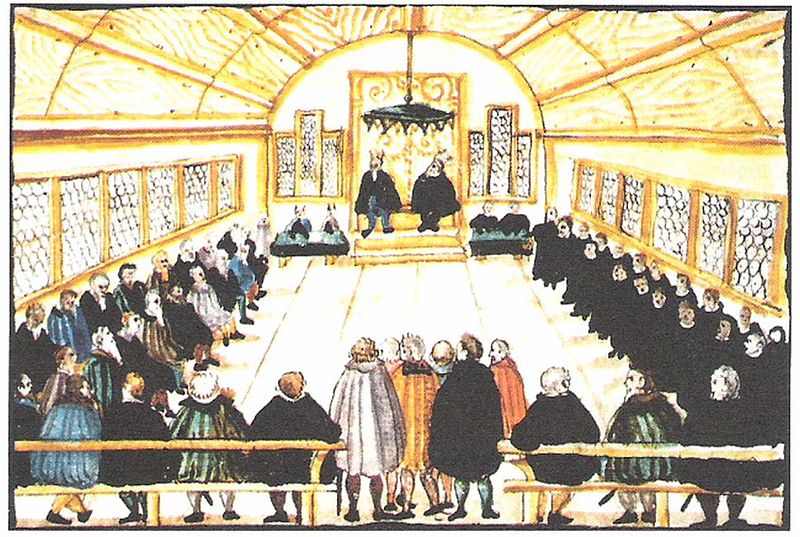
Anabaptists Parted from Zwingli in 1525 – Image Credit Wikimedia
Not every Reformer cared for the protection of secular authorities. Those working outside of magisterial protection came to be associated with the Radical Reformation.
One of the core tenets of the Radical Reformation was the idea of “Believer’s baptism” or credobaptism. Credobaptism (Baptism based on a creed) happened when someone professes faith in Christ. Credobaptism is opposed to paedobaptism or “infant baptism” which is performed on babies and children born into Christian families. Baptists, Amish, and others groups practice credobaptism while the majority of the denominations arising from the Magisterial Reformation still practice paedobaptism. During the Reformation, Credobaptists were called Anabaptists.
A contemporary of Luther, Thomas Müntzer (1489-1525) began in the mainstream of the German Reformation. Müntzer was a Catholic priest who decried the ecclesiastical hierarchy and veneration of the saints. However, he eventually became both more mystical in his outlook and revolutionary in his politics. Müntzer ended more like a cult leader than a Christian. After leading troops in the Peasant’s Revolt of 1524/1525 in Germany, Müntzer was caught, tried, and executed.
Menno Simons (1496-1561) tempered the revolutionary leanings of earlier Anabaptists like Müntzer. Instead of trying to overthrow the ruling order, Simons took the Bible more literally and sometimes legalistically by “turning the other cheek” and rejected the “sword philosophy” as he called it… Hunted by the Catholics and shunned by the Magisterial Reformers, Simons was one of the first Protestant Pacifists. Simons’ followers were the Mennonites.
“For no one can lay a foundation other than that which is laid, which is Jesus Christ.” (1 Corinthians 3:11)
Catholic Response in the Counter-Reformation
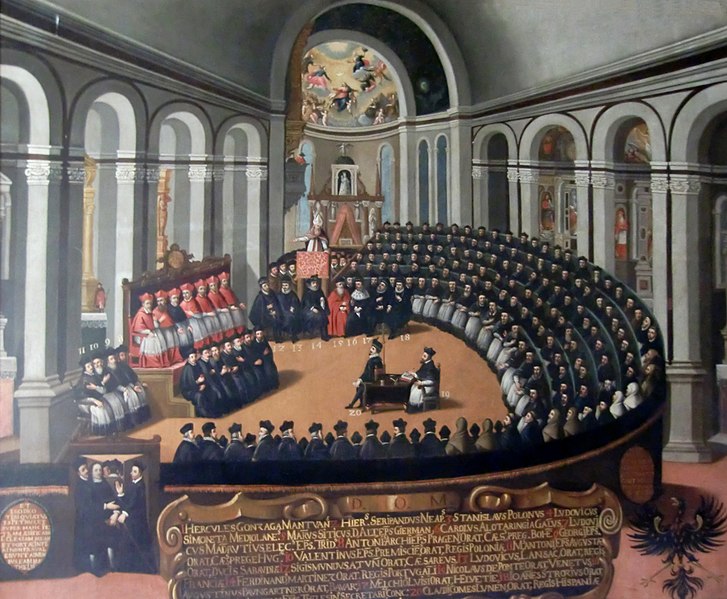
Council of Trent, painting in the Museo del Palazzo del Buonconsiglio, Trento – Image Credit Wikimedia
The Counter-Reformation or the Catholic Revival was the Catholic response to the Protestant Reformation. It consisted of a theological defence of Catholic doctrine, ecclesiastical changes, religious orders, and political changes – including the Thirty Years War (1618-1648). Two of the more important aspects of the Counter-Reformation were the Council of Trent and the the Jesuit movement.
The Council of Trent (1545-1563) was the official church council that condemned Protestant theology and reasserted Catholic doctrine. It pronounced the doctrine of justification by faith alone as a heresy, condemned the Protestant doctrine of Scripture alone as normative, and reaffirmed the doctrine of indulgences. The Council boldly declared anyone who held to these Protestant doctrines would be damned (let him be anathema). These condemnations have never been revoked by the Catholic Church. Instead of Reforming the Church’s theology, the Council of Trent solidified Catholic doctrines that led the to the Protestant Reformation.
Another aspect of the Catholic Counter-Reformation was the founding of many new religious orders, the most noteworthy was the Society of Jesus (aka the Jesuits). Founded by Ignatius of Loyola (1491-1556) just before the Council of Trent, the Jesuits implemented traditional Catholic doctrine in education and spread Catholicism through many missionary endeavors. Loyola recognized a need in the church for moral and structural reform, though he was a traditionalist in theological reform. The Jesuits are still one of the largest Catholic orders in the 21st century.
“Now the Spirit expressly says that in later times some will depart from the faith by devoting themselves to deceitful spirits and teachings of demons, through the insincerity of liars whose consciences are seared, who forbid marriage and require abstinence from foods that God created to be received with thanksgiving by those who believe and know the truth” (1 Timothy 4:1-3)
Lesson Of The Reformation: Christ Will Protect His Church
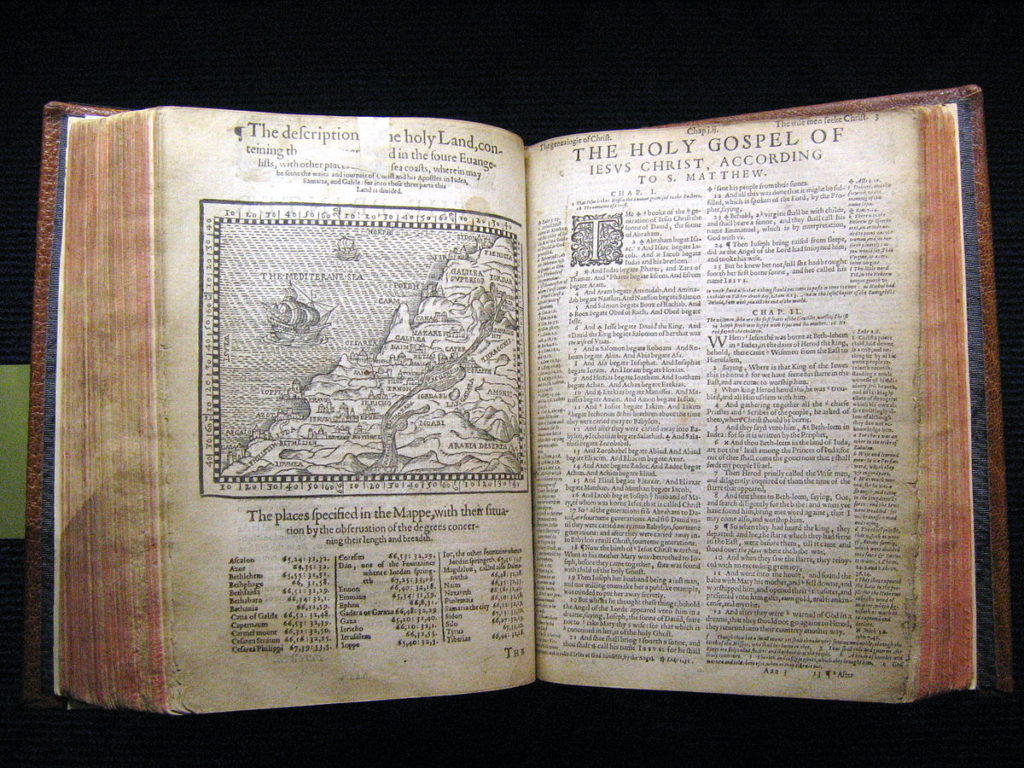
The Geneva Bible Preceded the King James Bible by 51 Years – Image Credit: Wikimedia
As I survey the history of the early Reformation, one thing becomes clear. Christ will protect his true church. The Reformers picked up on an idea found in Saint Augustine about the “invisible church”. That is the true church is not always what can be seen meeting in stone cathedrals in city centers. Instead, the genuine church (or true Christians) could consist of your local insurance lady, a construction supervisor, a homemaker, a barista, and a pastor – all redeemed by Christ’s blood and unified by His Spirit where the Word and Biblical Sacraments are ministered. This is the true church, then one where “the Lord knows those who are his.” (2 Timothy 2:19)
And when false doctrine takes root in a church, like what happened in the Catholic Church before the Reformation, God will raise up prophets and preachers to denounce those heresies and lead people back to His Word. Rome fell away and sealed their condemnation with the Council of Trent anathemas. But the true Church of God, the church invisible, will follow Christ and Scripture until he returns.
References
- Frank James: How The Protestant Reformation Started
- Tom Browning: The History of the Reformation (multiple PDFs)
- Steven J. Nichols: Does The Reformation Still Matter?

